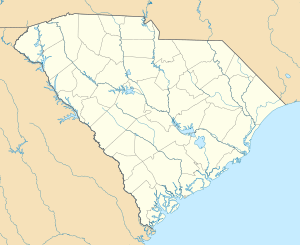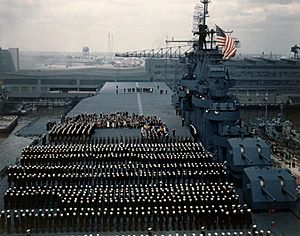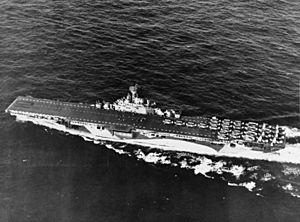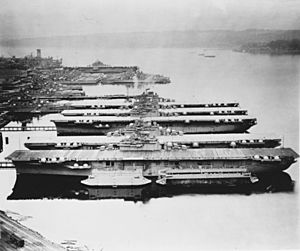USS Yorktown (CV-10) facts for kids
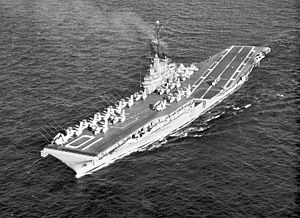
USS Yorktown at sea in the Pacific, 1963
|
|
Quick facts for kids History |
|
|---|---|
| Name | Yorktown |
| Namesake |
|
| Ordered | 3 July 1940 |
| Builder | Newport News Shipbuilding |
| Laid down | 1 December 1941 |
| Launched | 21 January 1943 |
| Acquired | 15 April 1943 |
| Commissioned | 15 April 1943 |
| Decommissioned | 9 January 1947 |
| Nickname(s) | The Fighting Lady |
| Recommissioned | 2 January 1953 |
| Decommissioned | 27 June 1970 |
| Reclassified |
|
| Stricken | 1 June 1973 |
| Status | Museum ship at Patriots Point in Mount Pleasant, South Carolina |
| General characteristics as built | |
| Class and type | Essex-class aircraft carrier |
| Displacement | |
| Length |
|
| Beam | 93 ft (28.3 m) |
| Draft | 34 ft 2 in (10.41 m) |
| Installed power |
|
| Propulsion |
|
| Speed | 33 knots (61 km/h; 38 mph) |
| Range | 14,100 nmi (26,100 km; 16,200 mi) at 20 knots (37 km/h; 23 mph) |
| Complement | 2,600 officers and enlisted men |
| Armament |
|
| Armor | |
| Aircraft carried | 90-100 aircraft |
| Nearest city | Mount Pleasant |
| Built | 1941 |
| Architect | Newport News Shipbldg. & Dry Dock |
| NRHP reference No. | 82001519 |
| Significant dates | |
| Added to NRHP | 10 November 1982 |
| Designated NHL | 19 June 1980 |
The USS Yorktown (CV/CVA/CVS-10) was a famous aircraft carrier built for the United States Navy during World War II. It was one of 24 ships in the Essex-class aircraft carrier class. Originally, it was going to be named Bonhomme Richard, but its name was changed to Yorktown to honor the USS Yorktown (CV-5), which was sunk during the Battle of Midway.
The Yorktown was launched in 1943 and played a big part in many battles in the Pacific Ocean. It earned 11 battle stars and a special award called the Presidential Unit Citation.
After the war, the ship was updated and used again in 1953 as an attack carrier. It served during the Korean War. Later, it was changed into an anti-submarine carrier and helped in the Vietnam War, earning five more battle stars.
The Yorktown also had a role in space history. In December 1968, it was the recovery ship for the Apollo 8 mission, which was the first time humans orbited the Moon. It even appeared in movies like Tora! Tora! Tora! and The Philadelphia Experiment.
In 1970, the Yorktown was taken out of service. Since 1975, it has been a museum ship at Patriots Point in Mount Pleasant, South Carolina. It is now a National Historic Landmark, meaning it's a very important historical site.
Contents
Building the Yorktown
Work on the ship, originally named Bonhomme Richard, began on December 1, 1941, at Newport News, Virginia. This was just six days before the Attack on Pearl Harbor. The ship's name was changed to USS Yorktown in September 1942. This was done to remember the USS Yorktown (CV-5), which was lost in the Battle of Midway.
The Yorktown was launched on January 21, 1943. Eleanor Roosevelt, the First Lady at the time, was its sponsor. The ship officially joined the Navy on April 15, 1943, with Captain Joseph J. Clark in charge.
World War II Service
After some training, the Yorktown headed to the Pacific Ocean in July 1943. It arrived in Pearl Harbor and then began its first combat mission. On August 31, it launched planes to attack Marcus Island, a Japanese base.
The carrier then went to San Francisco to load more planes and supplies. In October, its planes attacked Japanese bases on Wake Island. For the next month, the crew trained in the Hawaiian Islands.
Battles in the Pacific
In November 1943, Yorktown joined Task Force 38 for its first big mission: the invasion of the Gilbert Islands. Its planes attacked Japanese airfields on islands like Jaluit and Mili Atoll. This helped protect the troops landing on Tarawa, Abemama, and Makin.
In January 1944, the Yorktown supported the invasion of the Marshall Islands. Its aircraft bombed targets on Maloelap and Kwajalein Atolls. These attacks helped prepare for the ground troops' assaults.
Raids on Japanese Bases
Over the next few months, Yorktown took part in many raids across the Pacific. In February, its planes attacked the main Japanese base at Truk Atoll. These attacks were very successful.
The carrier also launched raids on Saipan in the Marianas. In March, its planes hit Japanese bases in the Palau Islands and Woleai.
In April, Yorktown supported General Douglas MacArthur's attack on Hollandia in New Guinea. Its planes provided direct support for the landing troops. After these missions, the carrier returned to Pearl Harbor for training.
Marianas and Palau Campaigns
In June 1944, Yorktown headed back to the Marianas. Its planes attacked airfields on Guam to prepare for the invasion of Saipan. The carrier then joined other ships to attack targets in the Bonin Islands.
On June 19, the Yorktown was part of the Battle of the Philippine Sea. Its planes fought against Japanese aircraft from Guam and from enemy carriers. Yorktown aircraft shot down 37 enemy planes and bombed Guam air bases.
The next day, Yorktown planes helped chase the Japanese fleet. They attacked the Zuikaku and other ships. After this battle, Yorktown continued to strike Japanese targets on Pagan Island, Iwo Jima, and Chichi Jima.
Philippines Campaign
In November 1944, Yorktown launched air strikes on the Philippines. These attacks supported the invasion of Leyte. In December, the task force sailed through a huge storm called Typhoon Cobra. Three destroyers sank, and Yorktown helped rescue survivors.
In January 1945, the carrier attacked targets in Formosa and the Philippines. Its planes entered the South China Sea and attacked Japanese ships and bases in Indochina, Canton, and Hong Kong.
Attacks on Japan and Iwo Jima
In February 1945, Yorktown launched planes to attack the Tokyo area of Honshū, Japan. It then supported the landings on Iwo Jima, with its aircraft providing support for the troops on the island.
In March, the carrier returned to strike airfields on Kyūshū, Honshū, and Shikoku. During these operations, the Yorktown was attacked by Japanese bombers. One bomb hit the ship, killing five men and wounding 26, but the carrier kept fighting.
Battle of Okinawa
From March 30, 1945, Yorktown focused its attacks on Okinawa. For weeks, its planes supported the troops fighting on the island. On April 7, the carrier's planes helped sink the huge Japanese battleship Yamato, which was on a desperate mission.
The Yorktown continued to support the Okinawa invasion, even though it faced more air attacks. It left the area in May for rest and repairs. After returning, it continued air support missions over Okinawa until early June.
End of World War II
In July 1945, Yorktown joined other carriers for the final attacks on Japan. Its planes bombed targets in Tokyo, Hokkaidō, and the Yokosuka naval base. They also attacked the Kure naval base.
On August 15, 1945, Japan agreed to surrender, and all planned attacks were canceled. The Yorktown then helped provide air cover for the forces occupying Japan. It also dropped supplies to Allied prisoners of war. On September 16, Yorktown entered Tokyo Bay.
After the War
After World War II, Yorktown returned to the United States. It helped bring American servicemen home. In January 1947, the ship was taken out of service and stored in Bremerton, Washington.
In 1952, the Yorktown was reactivated and updated. It was recommissioned in February 1953 as an attack carrier. It then served in the Sea of Japan during the Korean War armistice period, conducting training missions.
In 1954, the Yorktown was used to film the documentary Jet Carrier. It also helped evacuate Chinese Nationalists from the Tachen Islands in 1955.
Modernization and New Roles
In March 1955, Yorktown underwent major changes, including getting an angled flight deck to handle jet aircraft better. It was recommissioned in October 1955 and served with the 7th Fleet in the Pacific.
In September 1957, the Yorktown was reclassified as an antisubmarine warfare (ASW) aircraft carrier. This meant its main job was to hunt and destroy enemy submarines. It received more updates for this new role.
From 1958 to 1960, Yorktown served in the western Pacific. It earned the Armed Forces Expeditionary Medal for its presence near Quemoy and Matsu islands and off the coast of Vietnam during times of unrest.
Vietnam War Service
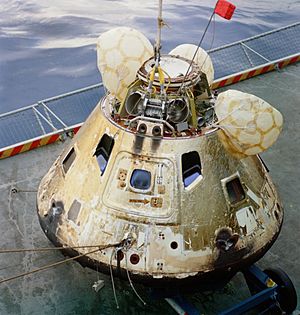
The Yorktown became involved in the Vietnam War in 1965. It provided anti-submarine warfare and search and rescue services for other carriers launching air strikes. It completed several tours of duty in the South China Sea.
In 1967, the ship underwent another overhaul. In 1968, it was sent to the Sea of Japan to support forces after North Korea captured the Pueblo. It then returned to Vietnam for more support missions.
Apollo 8 and Decommissioning
In late 1968, the Yorktown was used to film parts of the movie Tora! Tora! Tora!, which showed the Japanese attack on Pearl Harbor. In December 1968, it served as the main recovery ship for the Apollo 8 space mission. This was a huge moment, as Apollo 8 was the first crewed mission to orbit the Moon.
In 1969, Yorktown moved to the U.S. Atlantic Fleet and operated along the east coast and in Europe. On June 27, 1970, the Yorktown was officially taken out of service in Philadelphia.
Museum Ship Today
In 1974, the Navy decided to donate the Yorktown to the Patriot's Point Development Authority in Charleston, South Carolina. It was towed to Charleston in June 1975 and officially opened as a memorial on October 13, 1975. It was the first aircraft carrier to become a museum ship.
The Yorktown was named a National Historic Landmark in 1986. Today, it is the centerpiece of the Patriots Point Naval & Maritime Museum. The museum also features other ships, a Cold War Submarine Memorial, and a replica of a Vietnam Support Base. The Medal of Honor Society museum is located on the Yorktown's hangar deck.
In 2012, a college basketball game, the Carrier Classic, was planned on the Yorktown's deck. Over 8,000 veterans and military members attended, but the game was canceled due to wet conditions.
In 2015, engineers estimated that the ship's hull would need about $40 million in repairs. Work began by removing old fuel from its tanks.
Awards and Honors
The Yorktown earned many awards for its service:
- Presidential Unit Citation
- Meritorious Unit Commendation
- China Service Medal
- American Campaign Medal
- Asiatic-Pacific Campaign Medal with 11 stars
- World War II Victory Medal
- Navy Occupation Service Medal with "Asia" clasp
- National Defense Service Medal with 1 star
- Korean Service Medal
- Armed Forces Expeditionary Medal with 3 stars
- Vietnam Service Medal with 4 stars
- Philippine Presidential Unit Citation
- Republic of Vietnam Meritorious Unit Citation (Gallantry Cross)
- Philippine Liberation Medal
- United Nations Korean Medal
- Republic of Korea War Service Medal
- Republic of Vietnam Campaign Medal
See also
 In Spanish: USS Yorktown (CV-10) para niños
In Spanish: USS Yorktown (CV-10) para niños


